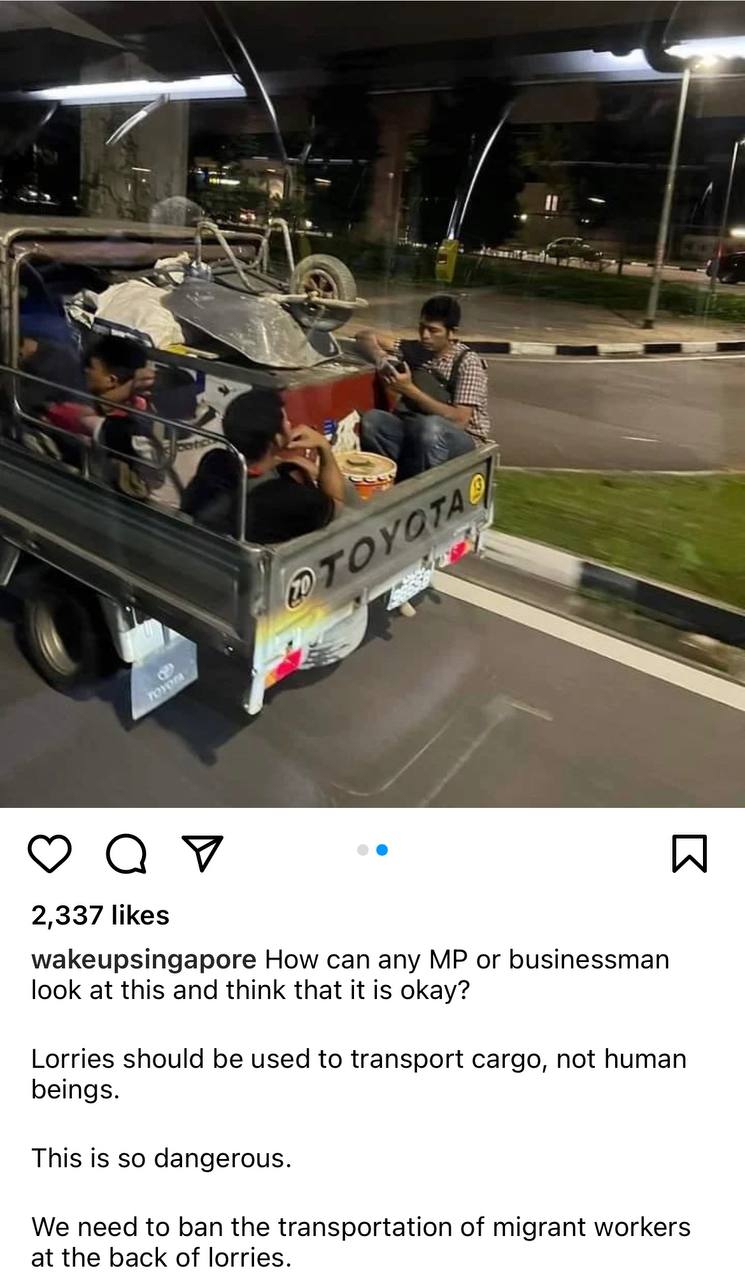The practice of ferrying migrant workers in lorries is back in the spotlight after an accident on the Kranji Expressway in July resulted in 26 workers being conveyed to the hospital.
Migrant worker groups want the government to ban it, calling it a dehumanising and unsafe practice.
Business groups have responded by urging restraint, citing "real, practical and operational complexities"
Parliamentarians have debated over it.
Even an ambassador-at-large has chimed in.
But what do our migrant workers have to say about it?
We spoke to three construction workers in Singapore about their experiences being ferried in lorries.
Why do employers ferry their migrant workers in lorries?
Sometimes, a company works multiple work sites. And so it needs to send teams of workers to multiple locations.
The most cost-efficient way is to try and pack as many workers as possible into a lorry -- up to the limit, of course -- and drop them off at the various work sites in one journey, said S, an Indian worker who has been in Singapore for five years.
It saves them time and money.
Employers also prefer a lorry because it is more versatile, said D who also came from India and has been working here for 13 years.
Lorries can be used to carry materials and equipment, unlike a bus.
 Via TWC2.
Via TWC2.
What issues do workers face when they are transported in lorries?
First of all, accidents can happen when multiple bodies packed together are hurtling forward at 60km per hour.
T, a Bangladeshi who has been working here for 10 years, said that his company's lorry can fit 16 workers. But don't forget: each worker also has to carry their equipment like safety boots and helmet, their food and other equipment.
 Screenshot of a recent Instagram post by Wake Up Singapore.
Screenshot of a recent Instagram post by Wake Up Singapore.
"We're sitting like animals," said T.
All it takes is for the driver to jam the brakes to send workers tumbling into each other and to the sides of the lorry.
"I cannot blame the driver because he is also a worker," said D, who added that this happens regularly, resulting in minor injuries to his hands and legs.
While rare, he has seen colleagues suffer fractures.
And when a serious accident -- like this incident on the PIE in 2021 -- occurs, workers can be sent flying out of the lorry.
Serious accidents like this leave T feeling a mix of emotions:
"I felt 'heart pain' because they are my nationality. But I also feel lucky that it wasn't me. I don't know if that might happen to me tomorrow."
The workers also spoke about being exposed to the elements, like heavy rain.
The back of the lorry gets covered in rain water whenever it pours, effectively turning the area into an impromptu wading pool.
When the workers are soaked to their skin and need to work all day in soggy boots, it can result in infections, which require medication and, if serious, sick leave, said D.
Then there is the issue about having adequate rest.
Because some companies chooses to ferry all their workers in one journey to save cost, some teams inevitably arrive at their work site much earlier than their starting time, simply because another team has to start work earlier.
Sometimes, the difference in starting times can be a few hours, said S.
This means the workers get less time to rest.
This worries S because without enough rest, workers cannot work safely.
When workers don't get enough rest, it affects their mental health, he said, adding that if they get injured, they worry about supporting their families.
"Workers just want to go to work safely and return to dormitory safely," he said.
"An injury will totally damage our lives. Our people are human, not animals."
Should employers use buses instead?
People have suggested that employers switch to ferrying workers in buses instead of lorries.
Being ferried in a bus is objectively safer than being transported in the back of a lorry. Individual seats can cushion sudden lurches and seatbelts provide additional protection.
However, both S and T are cognisant of the heavy impact that a change like this can have on smaller companies like the ones they work for.
"A bus makes sense for bigger companies that need to transport 30 to 50 workers," said S, adding that the cost of operating a bus for a handful of workers might not be as operationally feasible.
Instead, S wishes to see speed limits imposed for lorries transporting workers, and rules to prevent employers from making workers wake up for work earlier than necessary just to save cost.
D pointed out that if the government intends to enforce regulation against ferrying workers in lorries, it should do so in a calibrated fashion -- start with the bigger companies and help smaller companies make the switch by offering some kind of financial support.
"The rules should change slowly," he said, citing cost as a hurdle that smaller companies face.
Government: There are financial, structural, and operational challenges
The government, in response to recent petitions by migrant welfare advocates and businesses alike, affirmed that there are financial challenges that come with an outright ban on this practice.
They will affect small and medium enterprises disproportionately.
There are also structural and operational challenges, including the availability of alternative modes of transportation, as well as a current shortage of bus drivers in Singapore.
Top photo: Migrant Death Map.
If you like what you read, follow us on Facebook, Instagram, Twitter and Telegram to get the latest updates.



